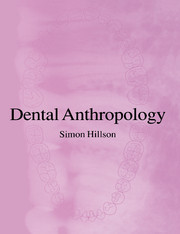Book contents
- Frontmatter
- Contents
- Acknowledgements
- Abbreviations
- 1 Introduction to dental anthropology
- 2 Dental anatomy
- 3 Variation in size and shape of teeth
- 4 Occlusion
- 5 Sequence and timing of dental growth
- 6 Dental enamel
- 7 Dentine
- 8 Dental cement
- 9 Histological methods of age determination
- 10 Biochemistry of dental tissues
- 11 Tooth wear and modification
- 12 Dental disease
- 13 Conclusion: current state, challenges and future developments in dental anthropology
- Appendix A: Field and laboratory methods
- Appendix B: Microscopy
- References
- Index
3 - Variation in size and shape of teeth
Published online by Cambridge University Press: 05 June 2012
- Frontmatter
- Contents
- Acknowledgements
- Abbreviations
- 1 Introduction to dental anthropology
- 2 Dental anatomy
- 3 Variation in size and shape of teeth
- 4 Occlusion
- 5 Sequence and timing of dental growth
- 6 Dental enamel
- 7 Dentine
- 8 Dental cement
- 9 Histological methods of age determination
- 10 Biochemistry of dental tissues
- 11 Tooth wear and modification
- 12 Dental disease
- 13 Conclusion: current state, challenges and future developments in dental anthropology
- Appendix A: Field and laboratory methods
- Appendix B: Microscopy
- References
- Index
Summary
Introduction
In Chapter 2, the different classes of teeth were described by defining an average or idealized form and then by outlining the range of variation, to facilitate identification of teeth even when their form is slightly aberrant. In this chapter, the aim is to define variation in form more closely and examine its distribution amongst the Hominidae. This subject has generated a larger literature than any other aspect of dental anthropology, and has inspired a series of International Symposia on Dental Morphology, including Fredensborg 1965 (Pedersen et al., 1967), London 1968 (Dahlberg, 1971), Cambridge 1974 (Butler & Joysey, 1978), Turku 1979 (Kurtén, 1982), Paris 1986 (Russell et al., 1988), Jerusalem 1989 (Smith & Tchernov, 1992), Florence 1992 (Moggi-Cecchi, 1995) and Berlin 1995 (Radlanski & Renz, 1995). One reason for this interest is that tooth crowns are formed full-size during childhood, so that their morphology can be studied in mixed collections of individuals of varying ages, whereas studies of skeletal morphology are based on fully grown adults to eliminate the factor of growth. Furthermore, living people (with known biological affinities) can be compared directly with ancient dental remains simply by taking dental impressions from their mouths.
Defining size and shape
Human eyes and brain are unsurpassed in discerning tiny differences between objects compared side by side, but it is much more difficult to define a scheme for recording size and shape in such a way that comparisons can be made between hundreds of such objects.
- Type
- Chapter
- Information
- Dental Anthropology , pp. 68 - 105Publisher: Cambridge University PressPrint publication year: 1996
- 2
- Cited by



